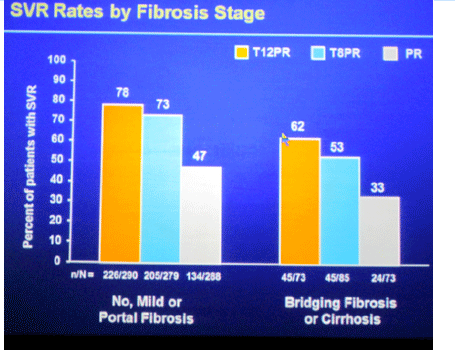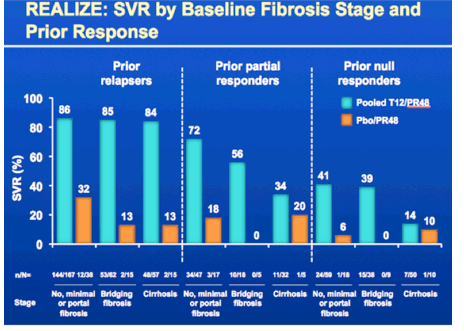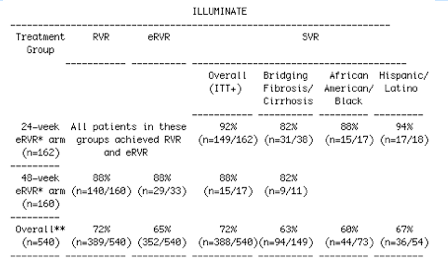| |
Telaprevir SVR & African-Americans, Latinos & Advanced Fibrosis
|
| |
| |
Reported by Jules Levin
62% of African Americans/Blacks achieved SVR with telaprevir compared to 25% of African Americans/Blacks who were treated with pegylated-interferon and ribavirin alone. Additionally, 62% of people with advanced liver fibrosis or cirrhosis (scarring of the liver) achieved SVR with telaprevir compared to 33% who were treated with pegylated-interferon and ribavirin alone. Old studies of peg/rbv in African-Americans yielded SVR rates of 5-26%.
African-Americans treatment-naïve: 61% had undetectable viral load at week 4 (RVR) and 46% at weeks 4 and 12 (eRVR)- 72% with RVR achieved SVR & 85% with eRVR achieved SVR. Similar for Latinos.


* 12 weeks of telaprevir (TVR), Pegasys(R) (PEG, pegylated-interferon alfa-2a) and Copegus(R) (RBV, ribavirin) followed by 12 or 36 weeks of only PEG and RBV, based on response to treatment at week 4 and week 12
** 8 weeks of telaprevir (TVR) Pegasys (PEG, pegylated-interferon alfa-2a) and Copegus (RBV, ribavirin) followed by 16 or 40 weeks of only PEG and RBV, based on response to treatment at weeks 4 and 12
*** 48 weeks of PEG and RBV + RVR: rapid viral response; undetectable (++ ervr:extended rapid viral response)(++ ervr:undetectable (+/- The SVR rates observed in the two telaprevir-based treatment arms were statistically significant when compared to the control arm
Relapse rates were 9% (27/314), 9% (28/295) and 28% (64/229) in the 12-week telaprevir-based arm, the 8-week telaprevir-based arm and the control arm, respectively
-----------------------
In ADVANCE patients who are eRVR- 54% achieved SVR with 48 weeks therapy, in the table immediately below. So presumable eRVR- African-Americans & advanced fibrotics had less than 54% SVR rate.

Overall rates of response with fibrosis in table below with 62% of fibrotics achieving SVR but for cihhotics & eRVR- I presume SVR rate in this study is less than 54% although the SVR rate for this group is not reported.

For prior partial responders receiving telapev+peg/rbv with bridging cirrhosis 56% (10/18) achieve SVR with 48 weeks therapy but 0 (0/5) do with peg/rbv; and 34% of cirrhotic partial responders receiving TLV+peg/rbv achieve SVR vs 20% with peg/rbv. Not as good for null responders: 39% with bridging fibrosis receiving triple therapy vs 0 receiving peg/rbv, 41% with no r little fibrosis vs 6% with PR, but for null responder cirrhotics 14% receiving triple vs 10% receiving PR achieved SVR.

Genotype 1a vs 1b
This is another consideration. As you can see in this table in the REALIZE study in treatment-experienced patients we see GT1a prior patients don't do as well as GT1b, this is now accepted as it has been seen in a number of studies, so if a patient is 1a cirrhotic null responder the expectation for SVR is less than for a 1b null responder cirrhotic.

Response Guided Therapy (24 weeks) for Blacks, Cirrhotics, and Latinos
Americans/Blacks whose virus was undetectable at weeks 4 and 12, 88% of people achieved SVR in both the 24-week and 48-week randomized treatment arms. As well, patients with more advanced liver disease (bridging fibrosis/cirrhosis) with undetectable HCV viral load (eRVR) at weeks 4 & 12 82% achieved SVR. And the same for Latinos with eRVR 94% achieved SVR; all with 24 weeks therapy. There was no control arm of pegylated-interferon and ribavirin alone in ILLUMINATE.
Overall patients

All patients received 12 weeks TVR combined with PEGASYS (PEG) and Copegus (RBV) plus either an additional 12 or 36 weeks with PEG/RBV alone.
* Reflects people whose hepatitis C virus was undetectable (** Overall efficacy analysis for patients treated with telaprevir in ILLUMINATE + ITT or intent-to-treat analysis
Relapse rates were 8% (37/469) overall and 6% (9/159) and 3% (4/154) in the 24-week and 48-week eRVR treatment groups respectively
| |
| |
| |
|
|
|